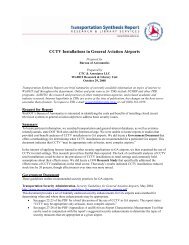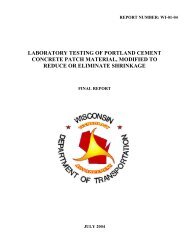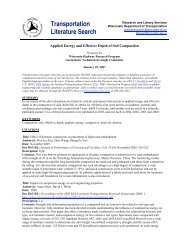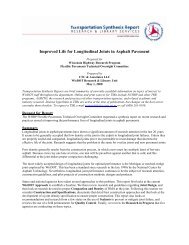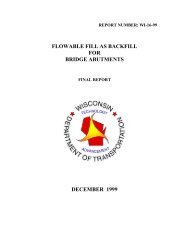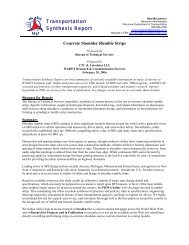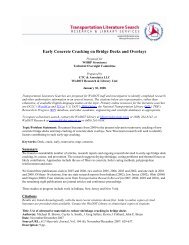Lateral Spreading of Soft Soils - WisDOT Research
Lateral Spreading of Soft Soils - WisDOT Research
Lateral Spreading of Soft Soils - WisDOT Research
Create successful ePaper yourself
Turn your PDF publications into a flip-book with our unique Google optimized e-Paper software.
Title: Construction-Engineering Techniques for S<strong>of</strong>t Ground<br />
Author(s): Gale, S. M.<br />
Year: 1998<br />
Source/URL: Geotechnical Fabrics Report, Industrial Fabrics Association International, pages 42-45;<br />
http://tris.trb.org/view.aspx?id=487600<br />
Description: 4 pages<br />
Contents: As granular fills and excavation costs have increased, many municipalities, counties, and state<br />
departments <strong>of</strong> transportation have chosen the staged-loading approach with a single geotextile layer, or a composite<br />
layer <strong>of</strong> a geogrid and a geotextile for reinforcing road embankments on s<strong>of</strong>t soil. This article reviews construction<br />
monitoring for this technique. The first step in the construction process is to prequalify the soil and geosynthetic<br />
materials based on the specification. A preconstruction meeting is essential to confirm that specification details are<br />
adhered to; this article includes a checklist <strong>of</strong> details. Designs for embankments on s<strong>of</strong>t and organic soils typically<br />
are based on limit-equilibrium stability analyses and an evaluation <strong>of</strong> bearing capacity, lateral spreading, and<br />
undrained and drained creep. The designer should analyze both total and effective stresses. When building on s<strong>of</strong>t<br />
and organic soils, it is also critical to monitor excess pore pressures created within the subsoil as a result <strong>of</strong><br />
embankment loading. Pneumatic piezometers are typically used for monitoring. Embankment-settlement monitoring<br />
is usually the least expensive and most meaningful parameter to obtain during construction. Continued settlement<br />
indicates dissipation <strong>of</strong> excess pore pressure and shear-strength gain. <strong>Lateral</strong> displacement <strong>of</strong> soil during<br />
embankment placement should be expected. The degree and location <strong>of</strong> movement can indicate creep-strain or<br />
potential failure.<br />
Title: Vertical and Horizontal Deformations <strong>of</strong> Foundations and Embankments<br />
Author(s): Yeung, Albert T. (ed.); Félio, Guy Y. (ed.)<br />
Year: 1994<br />
Source/URL: ASCE conference Settlement ’94; http://cedb.asce.org/cgi/WWWdisplay.cgi?90309<br />
Description: 1940 pages<br />
Contents: These proceedings, Vertical and Horizontal Deformations <strong>of</strong> Foundations and Embankments<br />
(Geotechnical Special Publication No. 40) consist <strong>of</strong> papers presented at the Specialty Conference sponsored by the<br />
Geotechnical Engineering Division <strong>of</strong> the American Society <strong>of</strong> Civil Engineers held in College Station, Texas, June<br />
16-18, 1994. The prime goals <strong>of</strong> the conference and the resulting proceedings were: 1) to update the progress made<br />
since the 1964 Speciality Conference on Design <strong>of</strong> Foundations for Control <strong>of</strong> Settlement on prediction methods and<br />
mitigation technologies for both vertical and horizontal deformation <strong>of</strong> different types <strong>of</strong> foundations and<br />
embankments built on different soils; 2) to provide an effective forum for researchers and practitioners to share<br />
research results, current practice and recent technological advances; 3) to recognize the limitations in current<br />
practice, identify current and future needs <strong>of</strong> the pr<strong>of</strong>ession, and assess the potential and feasibility <strong>of</strong> innovative<br />
technologies; and 4) to provide and effective vehicle for technology transfer. The 137 papers included in this<br />
publication cover such topics as: 1) embankments, deep fills, and landfills; 2) shallow foundations; 3) deep<br />
foundations; 4) soil improvement; 5) numerical and physical modeling; 6) soil dynamics; and 7) expansive soils,<br />
residual soils, and rock. These proceedings provide students, educators, researchers, and practitioners <strong>of</strong><br />
geotechnical engineering an opportunity to assimilate new information and to meet new challenges.<br />
Title: Comparison <strong>of</strong> Predicted and Measured Settlement <strong>of</strong> a Test Embankment over S<strong>of</strong>t Soil<br />
Author(s): Chang, Kuo-Hsia; Kovacs, William D.; Wu, Ming-Jiun<br />
Year: 1994<br />
Source/URL: From Vertical and Horizontal Deformations <strong>of</strong> Foundations and Embankments (see previous<br />
citation), pages 1164-1175; http://cedb.asce.org/cgi/WWWdisplay.cgi?88926<br />
Description: 12 pages<br />
Contents: Abstract not available<br />
4



